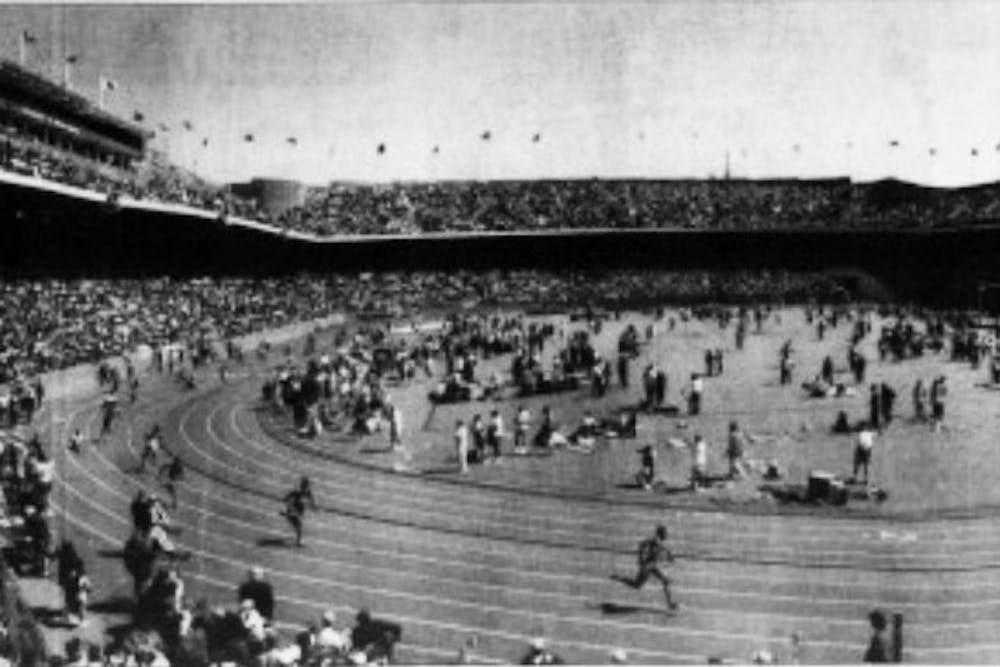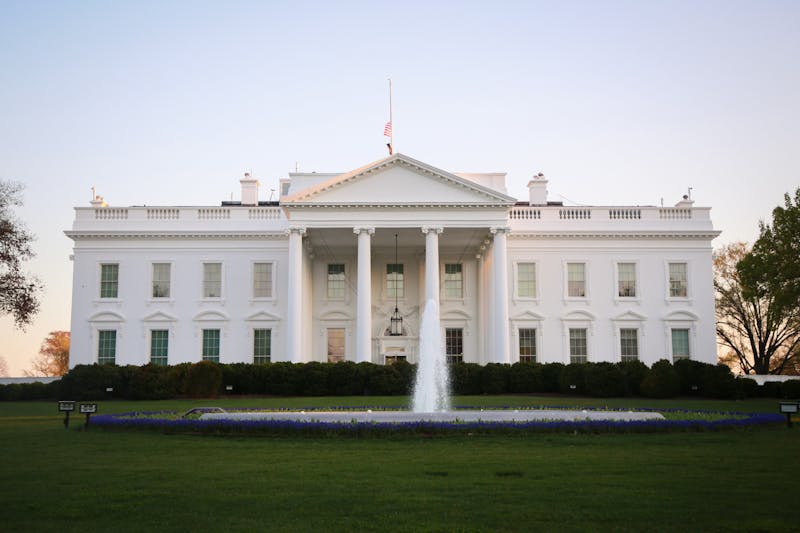
Franklin Field is packed during a Penn Relays in the late 1990s (Photo from the DP Archives).
With less than two weeks to go until the Penn Relays, also known as Penn Relay Carnival, let’s look back at how the one of the country's oldest and largest track and field meets first started, and how it's changed over the years.
In 1893, relay running began and as its popularity grew, it began to revive interest in Penn track — resulting in the University Track Committee sponsoring a relay meet in 1895. This meet became the first Penn Relays, and it was held on April 21, 1895 at Franklin Field, where it continues to be held today.
There were about 5000 attendees with nine 4x440-yard relay races on the schedule with two teams in each. The nine races were divided into the following divisions: four high school relays, four for colleges, and one college championship. A wide spread of different colleges attended the first Penn Relays including Cornell, Columbia, Harvard, Lafayette, Lehigh, Rutgers, Swarthmore, City College of New York, and New York University. The first college team to win a Penn Relays championship was Harvard University.
The next year, the entries for the 1896 Penn Relays quadrupled, and more events were added — including the five-mile relay, which eventually became the four-mile relay. The two-mile relay followed the year after.
The major change for the 1898 Penn Relays was in its scope. The University of Chicago became the first school from the Midwest to compete. In the following two years, more track events and now field events were added to the program including common sprint events, such as the 100-yard and 220-yard dash, and the 120-yard hurdles, as well as the high jump, pole vault, long jump, shot put, and hammer throw.
In 1910, the meet became known as the Penn Relay Carnival, due to the carnival-like tent set up at the meet. More changes continued through the next year when the college and high school championship events at Penn Relays became known as the “Championship of America” races. At the time, the Penn Relays were used as a sort of national championship, until the NCAA hosted their first official championship meet in 1921.
With Oxford University’s debut at Penn Relays in 1914, the meet officially became an international event. The British school was the first international team to compete and win a race: the four-mile relay. The year after, the meet also became a multi-day affair, spanning two days of competition instead of one — as it had in the years prior.
During the early and mid-1900s, the meet underwent more event additions and also proceeded to be held through the national crises of the Great Depression and World War II. In 1962, the first women’s events were held, starting with the 100y. The women’s Olympic development relay and the high school 440y relay followed in 1964.
One of the first steps in forming the Penn Relays we know today was in 1976. The meet switched to the metric system, causing the event schedule to begin to resemble today's operations. In addition, the following year, automatic timing was integrated into the meet, and the year after, more women’s events were added including the marathon and 20k road race. These events forced the meet to expand into a third day of competition, officially becoming the three-day meet it is now.
Throughout its history, Penn Relays has welcomed elite athletics from all levels, including high school, college, professional, and even Olympic. Some of the most notable Olympians who have competed at the Relays in recent years include Usain Bolt, Shelly-Ann Fraser, Alfred Kirwa Yego, Allyson Felix, and Sydney McLaughlin.
Jamaican Olympians Bolt, Fraser, Yego notably competed in 2010 in a “USA vs. The World” program — pitting American teams against elite international runners. American Olympian Allyson Felix attended Penn Relays consistently from 2005 to 2012 and was most notably part of the relay team that won the “USA vs. The World” relay event in 2012. She had been scheduled to attend last year’s program after the Relays were cancelled in 2020 and 2021 due to the COVID-19 pandemic, but she ultimately withdrew from the meet. Felix retired from professional running at the end of 2022. McLaughlin competed last year, and the New Jersey native was nostalgic given how she competed at Franklin Field during her high school years as well.
Fittingly, with football at Franklin Field and basketball at the Palestra, Penn Relays is yet another historic and monumental part of Penn, and track and field history. This year’s Penn Relays will be held from April 27-29, continuing the tradition of being held in the last week of April, and it will no doubt be a highlight of the 2023 Penn season.
The Daily Pennsylvanian is an independent, student-run newspaper. Please consider making a donation to support the coverage that shapes the University. Your generosity ensures a future of strong journalism at Penn.
Donate






